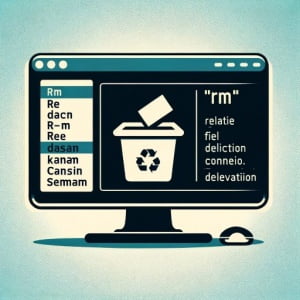‘rm’ Linux Command: Your Guide to File Deletion

Are you finding it challenging to delete files or directories in Linux? You’re not alone. Many users find themselves puzzled when it comes to managing their filesystem in Linux. Think of the ‘rm’ command as a professional cleaner – it’s a powerful tool that can help you tidy up your filesystem, removing unnecessary files and directories with ease.
This guide will walk you through the basics to advanced usage of the ‘rm’ command in Linux. We’ll cover everything from the simple deletion of files to more complex tasks, such as recursive deletion and forced deletion. We’ll also discuss alternative approaches and troubleshoot common issues that you might encounter.
So, let’s dive in and start mastering the ‘rm’ command in Linux!
TL;DR: How Do I Use the ‘rm’ Command in Linux?
To delete a file in Linux, you use the
'rm'command followed by the filename, for the complete syntax,rm [arguments] file. This command is your go-to tool for removing files or directories in your Linux filesystem.
Here’s a simple example:
rm myfile.txt
# Output:
# myfile.txt is deleted
In this example, we use the ‘rm’ command followed by the filename ‘myfile.txt’. Executing this command will delete the file named ‘myfile.txt’ from the current directory.
This is just the basic usage of the ‘rm’ command in Linux. There’s much more to learn about this command, including its options and flags for advanced usage, as well as alternative methods for file deletion. Continue reading for a more comprehensive guide.
Table of Contents
- Basic Use of ‘rm’ Command: A Beginner’s Guide
- Advanced Use of ‘rm’ Command: An Intermediate Guide
- Alternative Methods to ‘rm’ Command: Expert Insights
- Troubleshooting ‘rm’ Command: Common Issues and Solutions
- Understanding Linux Filesystem and ‘rm’ Command
- Exploring ‘rm’ Command in Larger Contexts
- Wrapping Up: Mastering the ‘rm’ Command in Linux
Basic Use of ‘rm’ Command: A Beginner’s Guide
The ‘rm’ command is one of the fundamental commands in Linux for managing files and directories. It stands for ‘remove’ and, as the name suggests, it’s used to delete files and directories.
The basic syntax of the ‘rm’ command is straightforward:
rm [filename]
Let’s take a look at a simple example:
rm example.txt
# Output:
# example.txt is deleted
In this example, we’re deleting a file named ‘example.txt’ in the current directory. After executing the command, ‘example.txt’ is removed from the filesystem.
That’s the basic use of the ‘rm’ command. It’s straightforward, but powerful. However, it’s important to note that using the ‘rm’ command is irreversible. Once you delete a file or directory with ‘rm’, it’s gone for good. So, always double-check your commands before pressing enter.
In the next section, we’ll delve into the more advanced uses of the ‘rm’ command, including its various options and flags.
Advanced Use of ‘rm’ Command: An Intermediate Guide
As you become more familiar with the ‘rm’ command, you’ll discover that it has a range of options or flags that can modify its behavior. These flags can make the ‘rm’ command more powerful and flexible, allowing you to handle more complex file and directory deletion tasks.
Let’s familiarize ourselves with some of the most commonly used ‘rm’ command flags:
| Flag | Description | Example |
|---|---|---|
-r or -R | Recursive removal. Allows the deletion of directories and their contents. | rm -r directoryname |
-f | Force deletion. Ignores nonexistent files and arguments, and never prompts. | rm -f filename |
-i | Interactive prompt before every removal. | rm -i filename |
-v | Verbose. Explains what is being done. | rm -v filename |
-d | Remove directories without prompting for confirmation. | rm -d directoryname |
--preserve-root | Do not remove ‘/’ (default). | rm --preserve-root |
--no-preserve-root | Do not treat ‘/’ specially. | rm --no-preserve-root |
--one-file-system | Skip directories on different file systems. | rm --one-file-system |
-I | Prompt once before removing more than three files, or when removing recursively. | rm -I |
-- | End of options. | rm -- -filename |
Now, let’s dive deeper into the advanced use of ‘rm’ command with some practical examples.
Recursive Deletion with ‘-r’
The ‘-r’ flag allows you to delete a directory and its contents recursively. Here’s an example:
rm -r mydirectory
# Output:
# 'mydirectory' and its contents are deleted
In this example, we’re deleting a directory named ‘mydirectory’ along with all its contents.
Forced Deletion with ‘-f’
The ‘-f’ flag allows you to force the deletion of files without prompting for confirmation. Here’s an example:
rm -f myfile.txt
# Output:
# 'myfile.txt' is deleted without prompting
In this example, we’re deleting a file named ‘myfile.txt’ without any prompts or confirmations.
Interactive Deletion with ‘-i’
The ‘-i’ flag prompts you for confirmation before removing each file. Here’s an example:
rm -i myotherfile.txt
# Output:
# Prompt: rm: remove regular file 'myotherfile.txt'?
# If 'y' is entered, 'myotherfile.txt' is deleted
In this example, we’re attempting to delete a file named ‘myotherfile.txt’. The ‘rm’ command asks for confirmation before deleting the file.
These are just a few examples of the advanced usage of the ‘rm’ command in Linux. By understanding and using these options, you can have more control over your file and directory deletions.
Alternative Methods to ‘rm’ Command: Expert Insights
While the ‘rm’ command is a powerful tool for deleting files and directories in Linux, it’s not the only method. There are alternative commands that can also accomplish file deletion tasks. Understanding these alternatives can provide you with more flexibility and control over your filesystem management. Let’s explore two such alternatives: the ‘unlink’ command and the ‘find’ command with the ‘-delete’ option.
The ‘unlink’ Command
The ‘unlink’ command is another way to delete a file in Linux. It does not work on directories, only files. Here’s an example of how to use ‘unlink’:
unlink myfile.txt
# Output:
# 'myfile.txt' is deleted
In the above example, we use ‘unlink’ to delete a file named ‘myfile.txt’. Unlike ‘rm’, ‘unlink’ does not have options or flags, and it can only delete one file at a time.
The ‘find’ Command with ‘-delete’ Option
The ‘find’ command is typically used to search for files or directories based on certain criteria. However, when combined with the ‘-delete’ option, it can also be used to delete files. This combination can be extremely powerful as it allows you to delete files based on complex search criteria. Here’s an example:
find . -name 'myfile.txt' -delete
# Output:
# 'myfile.txt' is deleted
In this example, we’re using ‘find’ to search for a file named ‘myfile.txt’ in the current directory (represented by ‘.’) and delete it. This method is particularly useful when you want to delete multiple files that match certain criteria.
These alternative methods provide additional ways to manage file deletion in Linux. While the ‘rm’ command is a versatile and powerful tool, understanding these alternatives can help you handle more complex file management tasks.
Troubleshooting ‘rm’ Command: Common Issues and Solutions
As with any command in Linux, you might encounter some issues while using the ‘rm’ command. These issues can stem from various factors, such as file permissions, non-existent files, or directories. Let’s discuss some of these common issues and how to resolve them.
‘Permission Denied’ Error
One common issue you might encounter is the ‘Permission denied’ error. This error occurs when you try to delete a file or directory without the necessary permissions.
Here’s an example:
rm protectedfile.txt
# Output:
# rm: cannot remove 'protectedfile.txt': Permission denied
In this example, we’re trying to delete a file named ‘protectedfile.txt’, but we don’t have the necessary permissions. To resolve this issue, you can use the ‘sudo’ command to execute ‘rm’ with root permissions:
sudo rm protectedfile.txt
# Output:
# 'protectedfile.txt' is deleted
‘No Such File or Directory’ Error
Another common issue is the ‘No such file or directory’ error. This error occurs when you try to delete a file or directory that does not exist.
Here’s an example:
rm nonexistingfile.txt
# Output:
# rm: cannot remove 'nonexistingfile.txt': No such file or directory
In this example, we’re trying to delete a file named ‘nonexistingfile.txt’, but the file does not exist. To avoid this issue, you can check if the file exists before trying to delete it:
[ -f nonexistingfile.txt ] && rm nonexistingfile.txt || echo 'File does not exist'
# Output:
# File does not exist
In this example, we’re using a conditional statement to check if ‘nonexistingfile.txt’ exists before trying to delete it. If the file does not exist, the command will output ‘File does not exist’.
These are just a few examples of the issues you might encounter while using the ‘rm’ command and how to resolve them. By understanding these issues and their solutions, you can use the ‘rm’ command more effectively and efficiently.
Understanding Linux Filesystem and ‘rm’ Command
Before we delve further into the ‘rm’ command, it’s crucial to understand some fundamental concepts about the Linux filesystem and file permissions.
The Linux Filesystem
In Linux, everything is a file: text files, directories, devices, and so on. The Linux filesystem is a hierarchical structure, starting from the root directory (represented by ‘/’) and branching out into various other directories and subdirectories.
When you execute the ‘rm’ command, you’re interacting with this filesystem. For example, if you’re in the ‘/home/user’ directory and you run ‘rm myfile.txt’, the ‘rm’ command will look for ‘myfile.txt’ in the ‘/home/user’ directory.
File Permissions in Linux
In Linux, each file and directory has a set of permissions that determine who can read, write, or execute it. These permissions can affect the ‘rm’ command. For instance, if you don’t have write permission on a file, you cannot delete it.
You can check the permissions of a file using the ‘ls -l’ command. Here’s an example:
ls -l myfile.txt
# Output:
# -rw-r--r-- 1 user group 0 Jan 1 00:00 myfile.txt
In this example, ‘myfile.txt’ has read and write permissions for the owner (‘user’), and only read permissions for the group and others.
Recursion in File Deletion
The concept of recursion is important in the context of file deletion. When you use the ‘rm’ command with the ‘-r’ or ‘-R’ option, you’re telling it to delete the directory and its contents recursively. This means it will delete the directory, go into the next level of directories, delete their contents, and so on, until all files and subdirectories within the specified directory are deleted.
Here’s an example:
rm -r mydirectory
# Output:
# 'mydirectory' and all its subdirectories and files are deleted
In this example, the ‘rm -r’ command deletes ‘mydirectory’ and all its contents, including any subdirectories and their contents.
Understanding these fundamental concepts can help you use the ‘rm’ command more effectively and troubleshoot any issues that might arise.
Exploring ‘rm’ Command in Larger Contexts
The ‘rm’ command, while simple in its essence, plays a significant role in larger scripts and projects. Understanding its functionality and how it interacts with other Linux concepts can provide you with a deeper understanding of Linux filesystem management.
‘rm’ Command in Scripts
In larger scripts, the ‘rm’ command can be used to manage files and directories dynamically. For instance, you might have a script that generates temporary files during its execution. Using the ‘rm’ command, you can ensure these temporary files are deleted once they’re no longer needed.
#!/bin/bash
# Generate a temporary file
temp_file=$(mktemp)
# Use the temporary file
echo 'This is a temporary file.' > $temp_file
cat $temp_file
# Delete the temporary file
rm $temp_file
# Output:
# This is a temporary file.
# 'temp_file' is deleted
In this script, we create a temporary file, use it, and then delete it using the ‘rm’ command. This kind of cleanup is common in larger scripts and projects.
Exploring Related Concepts
To fully grasp the ‘rm’ command, it’s beneficial to explore related concepts such as file permissions, inode, and filesystem hierarchy. Understanding file permissions can help you troubleshoot ‘Permission denied’ errors. The concept of inode, the unique identifier for each file and directory, can provide insights into how files and directories are managed in Linux. Lastly, understanding the filesystem hierarchy can help you navigate and manage your files and directories more effectively.
Further Resources for Mastering ‘rm’ Command
To continue your journey in mastering the ‘rm’ command and related concepts, here are some resources that you might find helpful:
- GNU Coreutils: rm invocation: This is the official documentation for the ‘rm’ command from GNU Coreutils. It provides a comprehensive overview of the command and its options.
Linux Filesystem Hierarchy: This guide from The Linux Documentation Project provides an in-depth look at the Linux filesystem hierarchy.
Understanding and Using File Permissions: This tutorial explains file permissions in Linux in an easy-to-understand manner.
By exploring these resources and practicing the ‘rm’ command, you can become more proficient in managing files and directories in Linux.
Wrapping Up: Mastering the ‘rm’ Command in Linux
In this comprehensive guide, we’ve delved into the ‘rm’ command in Linux, a fundamental tool for managing files and directories. We’ve explored its basic and advanced usage, discussed common issues, and provided solutions to help you manage your filesystem effectively.
We began with the basics, learning how to use the ‘rm’ command to delete files and directories. We then delved into more advanced usage, exploring the various options and flags that enhance the ‘rm’ command’s functionality. Along the way, we tackled common issues you might encounter when using the ‘rm’ command, such as ‘Permission denied’ and ‘No such file or directory’ errors, and provided solutions for each.
We also explored alternative methods to the ‘rm’ command, such as the ‘unlink’ command and the ‘find’ command with the ‘-delete’ option. These alternatives provide additional flexibility and control over file and directory deletion tasks.
Here’s a quick comparison of these methods:
| Method | Pros | Cons |
|---|---|---|
| ‘rm’ Command | Powerful, supports many options | Can be irreversible, requires caution |
| ‘unlink’ Command | Simple, easy to use | Only deletes files, not directories |
| ‘find’ Command with ‘-delete’ | Can delete files based on complex criteria | More complex to use |
Whether you’re just starting out with Linux or you’re looking to level up your filesystem management skills, we hope this guide has given you a deeper understanding of the ‘rm’ command and its capabilities.
With its balance of power and flexibility, the ‘rm’ command is an essential tool for managing files and directories in Linux. Happy coding!


